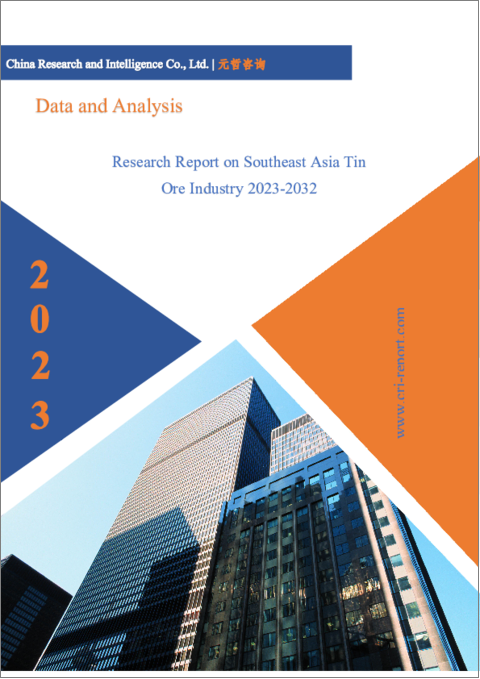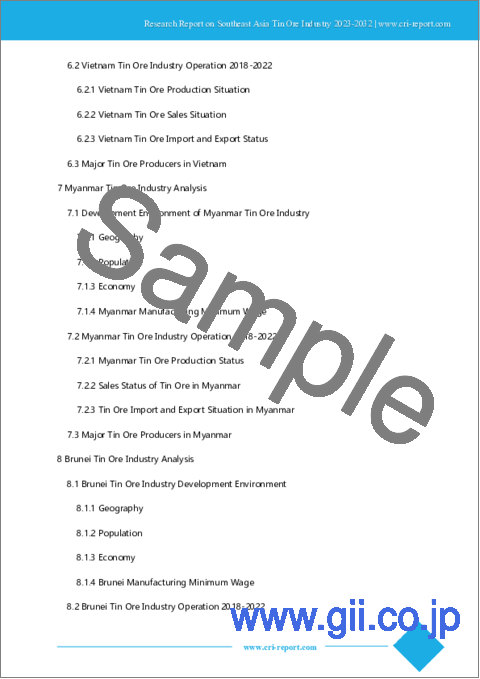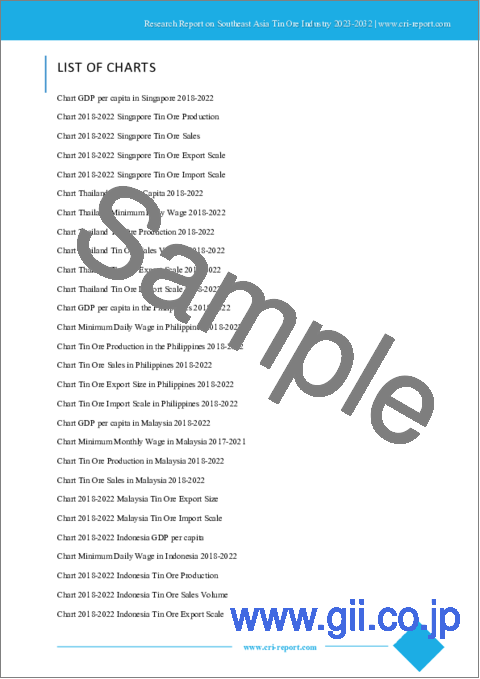|
|
市場調査レポート
商品コード
1178214
東南アジアの錫鉱石産業(2023年~2032年)Research Report on Southeast Asia Tin Ore Industry 2023-2032 |
||||||
| 東南アジアの錫鉱石産業(2023年~2032年) |
|
出版日: 2022年12月28日
発行: China Research and Intelligence
ページ情報: 英文 80 Pages
納期: 即日から翌営業日
|
- 全表示
- 概要
- 目次
東南アジアは人件費が安く、鉱物資源が豊富なため、近年、多くの外国企業が東南アジアに鉱業企業を設立しています。2023年から2032年にかけて、ますます多くの外国企業が東南アジアに錫鉱石などの鉱物資源採掘企業を設立し、東南アジアの鉱物資源輸出は引き続き増加すると予測されています。
当レポートでは、東南アジアの錫鉱石市場を調査し、市場の概要、市場の促進要因・抑制要因の分析、市場機会、COVID-19の影響、セグメント別の市場分析、競合情勢、主要企業のプロファイルなど、体系的な情報を提供しています。
目次
第1章 シンガポールの錫鉱石産業の分析
- 産業の発展環境
- 地域
- 人口
- 経済
- 製造業の最低賃金
- 産業オペレーション(2018年~2022年)
- 生産状況
- 販売状況
- 輸出入状況
- 主要な製造業者
第2章 タイの錫鉱石産業の分析
- 産業の発展環境
- 地域
- 人口
- 経済
- 製造業の最低賃金
- 産業オペレーション(2018年~2022年)
- 生産状況
- 販売状況
- 輸出入状況
- 主要な製造業者
第3章 フィリピンの錫鉱石産業の分析
- 産業の発展環境
- 地域
- 人口
- 経済
- 製造業の最低賃金
- 産業オペレーション(2018年~2022年)
- 生産状況
- 販売状況
- 輸出入状況
- 主要な製造業者
第4章 マレーシアの錫鉱石産業分析
- 産業の発展環境
- 地域
- 人口
- 経済
- 製造業の最低賃金
- 産業オペレーション(2018年~2022年)
- 生産状況
- 販売状況
- 輸出入状況
- 主要な製造業者
第5章 インドネシアの錫鉱石産業分析
- 産業の発展環境
- 地域
- 人口
- 経済
- 製造業の最低賃金
- 産業オペレーション(2018年~2022年)
- 生産状況
- 販売状況
- 輸出入状況
- 主要な製造業者
第6章 ベトナムの錫鉱石産業分析
- 産業の発展環境
- 地域
- 人口
- 経済
- 製造業の最低賃金
- 産業オペレーション(2018年~2022年)
- 生産状況
- 販売状況
- 輸出入状況
- 主要な製造業者
第7章 ミャンマーの錫鉱石産業分析
- 産業の発展環境
- 地域
- 人口
- 経済
- 製造業の最低賃金
- 産業オペレーション(2018年~2022年)
- 生産状況
- 販売状況
- 輸出入状況
- 主要な製造業者
第8章 ブルネイの錫鉱石産業分析
- 産業の発展環境
- 地域
- 人口
- 経済
- 製造業の最低賃金
- 産業オペレーション(2018年~2022年)
- 生産状況
- 販売状況
- 輸出入状況
- 主要な製造業者
第9章 ラオスの錫鉱石産業の分析
- 産業の発展環境
- 地域
- 人口
- 経済
- 製造業の最低賃金
- 産業オペレーション(2018年~2022年)
- 生産状況
- 販売状況
- 輸出入状況
- 主要な製造業者
第10章 カンボジアの錫鉱石産業分析
- 産業の発展環境
- 地域
- 人口
- 経済
- 製造業の最低賃金
- 産業オペレーション(2018年~2022年)
- 生産状況
- 販売状況
- 輸出入状況
- 主要な製造業者
第11章 東南アジアの錫鉱石産業の見通し(2023年~2032年)
- 産業の発展に影響を与える要因の分析
- 有利な要因
- 不利な要因
- 産業の供給予測(2023年~2032年)
- 製造市場の需要予測(2023年~2032年)
- 産業に対するCOVID-19の影響
Mining is the activity of extracting economically valuable minerals or other substances from the ground in deposits with a high concentration of minerals. Mining extracts substances such as bauxite, coal, diamonds, iron, rare metals, lead, limestone, nickel, phosphorus, rock salt, tin, uranium and molybdenum.
Southeast Asia in this report includes 10 countries: Singapore, Thailand, Philippines, Malaysia, Indonesia, Vietnam, Myanmar, Brunei, Laos and Cambodia. With a total population of over 600 million by the end of 2021, Southeast Asia has an overall economic growth rate higher than the global average and is one of the key drivers of future global economic growth.
Due to the degree of economic development, technology level and other reasons, the mineral resources in Southeast Asia are less explored. However, as far as the proven resources are concerned, Southeast Asia is rich in mineral resources, and the main minerals include: copper, gold, nickel, aluminum, tin, titanium, antimony, silver, potash, gypsum, barite and phosphorus, as well as iron, zinc, lead, chromium, manganese, cobalt, kaolin, etc.
Tin is mainly used in the metallurgical industry for the production of tin-plated sheets (tinplate) and various alloys. Tin-plated sheet is the main area of tin consumption, accounting for about 40% of tin consumption, and it can be used as containers for food and beverages, various packaging materials, household items, etc. The low melting point alloy composed of tin-lead and a small amount of antimony is solder tin, which accounts for about 20% of tin consumption. Bearing alloy is an alloy of tin, lead, antimony and copper. Bronze containing tin is widely used in ships, chemicals, construction, currency and many other applications. Tin can also be made into a variety of alloys with other metals.
The global tin resource reserves are just over 4 million tons, and tin ore is distributed in a belt, with the Pacific region being the main deposit area, mainly distributed in two major tin belts in Southeast Asia and East Asia. The tin belt in Southeast Asia starts from the Shan Plateau in Myanmar in the north, and extends southward along the Myanmar-Thailand border through the western part of the Malay Peninsula to Pangas Island and Bedok Island in Indonesia. It is also known as the "Tin-Tungsten Belt" because it is accompanied by tungsten. Tin reserves in Southeast Asia account for 60% of the world's total reserves. According to CRI's analysis, tin is mined in Malaysia, Indonesia, Thailand, Vietnam, Laos and other countries in Southeast Asia.
Due to the lower labor costs in Southeast Asia, coupled with the abundance of mineral resources, a large number of foreign companies have set up mining enterprises in Southeast Asia in recent years. CRI expects that in 2023-2032, more and more foreign companies will set up tin and other mineral mining enterprises in Southeast Asia, and Southeast Asian mineral exports are expected to continue to rise.
Topics covered:
Southeast Asia Tin Ore Industry Status and Major Sources in 2018-2022
What is the Impact of COVID-19 on Southeast Asia Tin Ore Industry?
Which Companies are the Major Players in Southeast Asia Tin Ore Industry Market and What are their Competitive Benchmarks?
Key Drivers and Market Opportunities in Southeast Asia Tin Ore Industry
What are the Key Drivers, Challenges, and Opportunities for Southeast Asia Tin Ore Industry during 2023-2032?
What is the Expected Revenue of Southeast Asia Tin Ore Industry during 2023-2032?
What are the Strategies Adopted by the Key Players in the Market to Increase Their Market Share in the Industry?
What are the Competitive Advantages of the Major Players in Southeast Asia Tin Ore Industry Market?
Which Segment of Southeast Asia Tin Ore Industry is Expected to Dominate the Market in 2032?
What are the Major Adverse Factors Facing Southeast Asia Tin Ore Industry?
Table of Contents
1 Analysis of the Tin Ore Industry in Singapore
- 1.1 Singapore Tin Ore Industry Development Environment
- 1.1.1 Geography
- 1.1.2 Population
- 1.1.3 Economy
- 1.1.4 Singapore Manufacturing Minimum Wage
- 1.2 Singapore Tin Ore Industry Operation 2018-2022
- 1.2.1 Singapore Tin Ore Production Status
- 1.2.2 Singapore Tin Ore Sales Status
- 1.2.3 Singapore Tin Ore Import and Export Status
- 1.3 Analysis of Major Tin Ore Producers in Singapore
2 Analysis of Thailand Tin Ore Industry
- 2.1 Development Environment of Thailand's Tin Ore Industry
- 2.1.1 Geography
- 2.1.2 Population
- 2.1.3 Economy
- 2.1.4 Thailand Manufacturing Minimum Wage
- 2.2 Thailand Tin Ore Industry Operation 2018-2022
- 2.2.1 Thailand Tin Ore Production Status
- 2.2.2 Thailand Tin Ore Sales Situation
- 2.2.3 Thailand Tin Ore Import and Export Status
- 2.3 Major Tin Ore Producers in Thailand
3 Analysis of Tin Ore Industry in the Philippines
- 3.1 Development Environment of Tin Ore Industry in the Philippines
- 3.1.1 Geography
- 3.1.2 Population
- 3.1.3 Economy
- 3.1.4 Philippines Manufacturing Minimum Wage
- 3.2 Philippine Tin Ore Industry Operation 2018-2022
- 3.2.1 Tin Ore Production in the Philippines
- 3.2.2 Sales Status of Tin Ore in the Philippines
- 3.2.3 Philippine Tin Ore Import and Export Status
- 3.3 Major Tin Ore Producers in the Philippines
4 Malaysia Tin Ore Industry Analysis
- 4.1 Malaysia Tin Ore Industry Development Environment
- 4.1.1 Geography
- 4.1.2 Population
- 4.1.3 Economy
- 4.1.4 Malaysia Manufacturing Minimum Wage
- 4.2 Malaysia Tin Ore Industry Operation 2018-2022
- 4.2.1 Malaysia Tin Ore Production Status
- 4.2.2 Malaysia Tin Ore Sales Status
- 4.2.3 Malaysia Tin Ore Import and Export Status
- 4.3 Major Tin Ore Producers in Malaysia
5 Indonesia Tin Ore Industry Analysis
- 5.1 Development Environment of Indonesia Tin Ore Industry
- 5.1.1 Geography
- 5.1.2 Population
- 5.1.3 Economy
- 5.1.4 Indonesia Manufacturing Minimum Wage
- 5.2 Indonesia Tin Ore Industry Operation 2018-2022
- 5.2.1 Indonesia Tin Ore Production Status
- 5.2.2 Indonesia Tin Ore Sales Status
- 5.2.3 Indonesia Tin Ore Import and Export Status
- 5.3 Major Tin Ore Producers in Indonesia
6 Vietnam Tin Ore Industry Analysis
- 6.1 Development Environment of Tin Ore Industry in Vietnam
- 6.1.1 Geography
- 6.1.2 Population
- 6.1.3 Economy
- 6.1.4 Vietnam Manufacturing Minimum Wage
- 6.2 Vietnam Tin Ore Industry Operation 2018-2022
- 6.2.1 Vietnam Tin Ore Production Situation
- 6.2.2 Vietnam Tin Ore Sales Situation
- 6.2.3 Vietnam Tin Ore Import and Export Status
- 6.3 Major Tin Ore Producers in Vietnam
7 Myanmar Tin Ore Industry Analysis
- 7.1 Development Environment of Myanmar Tin Ore Industry
- 7.1.1 Geography
- 7.1.2 Population
- 7.1.3 Economy
- 7.1.4 Myanmar Manufacturing Minimum Wage
- 7.2 Myanmar Tin Ore Industry Operation 2018-2022
- 7.2.1 Myanmar Tin Ore Production Status
- 7.2.2 Sales Status of Tin Ore in Myanmar
- 7.2.3 Tin Ore Import and Export Situation in Myanmar
- 7.3 Major Tin Ore Producers in Myanmar
8 Brunei Tin Ore Industry Analysis
- 8.1 Brunei Tin Ore Industry Development Environment
- 8.1.1 Geography
- 8.1.2 Population
- 8.1.3 Economy
- 8.1.4 Brunei Manufacturing Minimum Wage
- 8.2 Brunei Tin Ore Industry Operation 2018-2022
- 8.2.1 Brunei Tin Ore Production Status
- 8.2.2 Brunei Tin Ore Sales Status
- 8.2.3 Brunei Tin Ore Import and Export Status
- 8.3 Brunei Major Manufacturing Companies
9 Analysis of the Tin Ore Industry in Laos
- 9.1 Development Environment of the Tin Ore Industry in Laos
- 9.1.1 Geography
- 9.1.2 Population
- 9.1.3 Economy
- 9.1.4 Minimum Wage of Manufacturing Industry in Laos
- 9.2 Operation of the Tin Ore Industry in Laos 2018-2022
- 9.2.1 Laos Tin Mining Production Status
- 9.2.2 Sales Status of Tin Ore in Laos
- 9.2.3 Import and Export Status of Tin Ore in Laos
- 9.3 Major Tin Ore Producers in Laos
10 Cambodia Tin Ore Industry Analysis
- 10.1 Development Environment of Cambodia Tin Ore Industry
- 10.1.1 Geography
- 10.1.2 Population
- 10.1.3 Economy
- 10.1.4 Minimum Wage of Manufacturing Industry in Cambodia
- 10.2 Cambodia Tin Ore Industry Operation 2018-2022
- 10.2.1 Cambodia Tin Ore Production Status
- 10.2.2 Cambodia Tin Ore Sales Status
- 10.2.3 Cambodia Tin Ore Import and Export Situation
- 10.3 Major Tin Ore Producers in Cambodia
11 Southeast Asia Tin Ore Industry Outlook 2023-2032
- 11.1 Analysis of Factors Affecting the Development of Tin Ore Industry in Southeast Asia
- 11.1.1 Favorable Factors
- 11.1.2 Unfavorable Factors
- 11.2 Southeast Asia Tin Ore Industry Supply Forecast 2023-2032
- 11.3 Southeast Asia Tin Ore Manufacturing Market Demand Forecast 2023-2032
- 11.4 Impact of COVID -19 Epidemic on Tin Ore Industry




